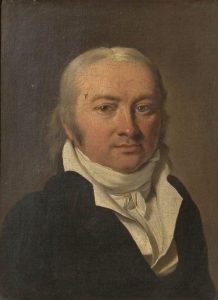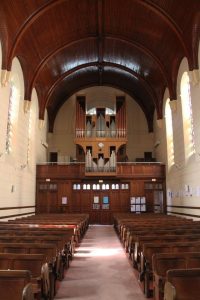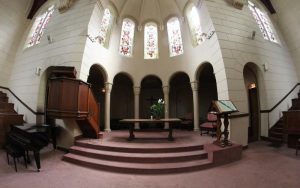Pastors, theologians
Klaus Hottinger (1467-1524), a disciple of Zwingli, was the first martyr of the Swiss Protestant movement. In the family were theologians, such as Johann Heinrich (1620-1667), or scientists like Klaus’s grandson Hans-Heinrich (1620-1667), known as Johann-Heinrich Hottinger, a famous orientalist, theology historian, and dean of Heidelberg University.
Sébastien Hottinger (1538-1600), the brother of Hans-Heinrich, was a doctor and member of the Municipal Council of Zurich. His grandson Hans-Rudolf Hottinger (1600-1670) was at the head of a new Hottinger line of clerics. His son Rudolf (1642-1692), and his grandson Hans-Rudolf (1673-1732), also were pastors.
And bankers
Hans-Konrad Hottinguer, Johann-Konrad (1764-1841) or Jean-Conrad was merely 26 years old when he opened a banking trade named ‘Messieurs Rougemont et Hottinguer’ in Paris where his family sent him for an internship. As early as 1787, the bank was listed in the Royal Almanac. It was located on the rue Croix-des-Petits-Champs, in the Hôtel de Beaupréaux, and became in 1790 the institution called ‘Messieurs Hottinguer & Cie, banquiers à Paris’. In 1793, Johann-Konrad was sued for ‘royalist activities’ and fled to Zurich and then to England where he married Martha Eliza Redwood, the daughter of an American planter, born in Newport, USA. In 1794 the couple went to the United States and met a group of French immigrants, Talleyrand was one of them. In January 1798, when Jean-Conrad came back to Europe he had a premonition about the role of banks in the market economy, and he was appointed Régent de la Banque de France in 1803. For over a century, the Hottinguer were continuously on the board of directors.
The name ‘Hottinger’ was gallicised into ‘Hottinguer’ in 1810 when he was granted a Baron of the Empire patent. In 1818, Jean-Conrad founded the Caisse d’Epargne de Paris with the Delessert family. In 1819 he purchased the château du Piple located between Boissy-St-Léger and Sucy en Brie. The Hottinguer family rarely lived there during the early years.
Jean-Henri Hottinguer (1803-1866) studied in London, New York and New Orleans before succeeding his father in 1833. He was a renowned banker, as testified by his appointment as Régent de la Banque de France that very same year, and two years later as Director of the Caisse d’Epargne et de Prévoyance de Paris, founded by his father and the Delessert family. In 1832 he married Caroline Delessert and took over the Banque Delessert in 1848. The Hottinguer Firm became one of the major international companies trading with the United States, and specialised in cotton and colonial goods. In 1835, he took part in creating the coal mines and railways of Epinac corporation with the Mallet family, thus asserting the prominent role of the high Protestant bank in the development of the steel industry in the Lorraine region.
Caroline Delessert Hottinguer conducted charity work with her own money. She set up a dormitory with six beds and six cradles for destitute women who had just given birth, which anticipated the maternal Asylum. She turned the Château du Piple into a luxury residence, where their son Henri-François was born in 1846. Their deep-rootedness in Boissy-St-Léger led Jean-Henri to be Mayor of the city from 1844 to 1852. Jean-Henri contributed to the financing of the railway line from Paris-Bastille to Boissy-Saint-Léger, which was prolonged to Brie-Comte-Robert and managed by the Company of the East, of which he was the executive director. In September 1859, the railway line reached Saint-Maur, and in 1872 Sucy and Bonneuil.
Jean-Henri and his wife Caroline took part in the SEIPP project, i.e. « Société pour l’encouragement de l’instruction primaire parmi les protestants de France » ‘Society to promote primary education among Protestants in France’. The association was created in 1828 to develop schools and training of Protestants schoolteachers, especially for young ladies, because there were few schools for girls in France.
Jean-Henri gave the association, of which he was the vice-president, land and a large building which he financed and was turned into a female schoolteachers training college comprising a girl’s boarding school. He also gave an yearly annuity for its maintenance. In 1859 a small boarding school was set up for 7 to 15 year-olds, and was a ‘small school’ of application for training female schoolteachers.
At the same time, Caroline Delessert, who grew up in the Passy village, which became part of the Paris district in 1860, where she owned several building, promoted the development of a Sunday school in her childhood property. She was supported by Eugène Casalis, a missionary pastor, and asked him to preside over worship in the Passy-Annonciation Protestant Church to be in 1856.
The Hottinguer couple set about having a Protestant, or ‘evangelical chapel’, built in Boissy-St-Léger, to be used as a chapel for the château du Piple, for the training college and as a worship place for the Protestants in the neighbourhood.
Caroline Hottinguer bequeathed to her eldest son Rodolphe, her state attorney, the care of the Passy parish. In 1881, a year after she died, he signed the purchase of land on the rue Cortambert, in Paris 16th arrondissement, where the Passy temple was later erected. Pastor Casalis, who died in 1891 aged 79, was the only pastor in Passy until 1878. Then he was assisted till he retired in 1882.
Caroline Delessert, baroness Hottinguer, was buried in the Hottinguer family tomb in Boissy-St-Léger, contrary to most Delessert family members who rest in the Passy cemetery, since their tombs were transferred in 1959.
Rodolphe Hottinguer (1835-1920) trained in Liverpool, in Russia and in the United States. He married Marie-Louise de Bethmann en 1867. Régent de la Banque de France from 1869 to 1920, he played a role in setting up the Ottomane Bank in 1862. In 1870 he was a member of the Board of Directors of the Caisse d’Epargne de Paris.
The family still exists.

















